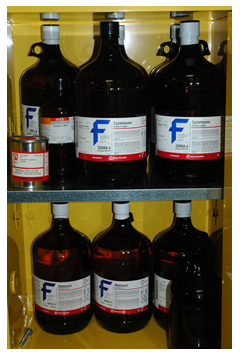Aviso de archivo
Esta es una página de archivo que ya no se actualiza. Puede contener información desactualizada y es posible que los enlaces ya no funcionen como se pretendía originalmente.
Home | Glossary | Resources | Help | Contact Us | Course Map
The Chemical Hygiene Plan will address general and specific hazards that exist within the laboratory and the controls to manage and/or avoid them. OSHA has promulgated non-mandatory standards that will assist with the creation of an appropriate Chemical Hygiene Plan. Be aware that some states have an OSHA-approved state plan that may differ from the federal OSHA regulations. The OSHA references for creating or updating a Chemical Hygiene Plan are:
- 29 CFR 1910.1450 National Research Council Recommendations Concerning Chemical Hygiene in Laboratories (non-mandatory) and its Appendix A and Appendix B.
The laboratory's Chemical Hygiene Plan should encompass a number of topics including, but not limited to:11-13
- Standard operating procedures for laboratory chemicals
- Procedures for chemical procurement, receipt, and handling
- Identification of personnel responsible for laboratory chemicals
- Chemical inventory
- Chemical storage
- Chemical handling
- Definitions of chemical hazards
- Toxins, corrosives, allergens, asphyxiants, carcinogens, reproductive/embryo toxins
- Compressed gases
- Radiation protection program
- Monitoring, exposure, training
- Personal protective equipment
- Methods/routes of contamination
- Inhalation, absorption, ingestion, injection
- General laboratory work practices
- Grooming, appropriate attire, working alone, handling of chemicals
- Criteria for the implementation of control measures
- Engineering controls employed in the laboratory
- Employee information and training
- Medical information
- Specific information covering the "Who, what, when, why, and how"
- Chemical Hygiene Plan responsibilities
- Safety officer
- Safety committee
- Lab director
- Supervisors
- Employees
- Employer
- Record keeping
- Annual audit
- References and recommended reading
The plan should address safety needs in specific testing areas, as required. For example, if the laboratory has a firearms section, it will have protocols for lead testing and general (physical) safety.
Additional Online Courses
- What Every First Responding Officer Should Know About DNA Evidence
- Collecting DNA Evidence at Property Crime Scenes
- DNA – A Prosecutor’s Practice Notebook
- Crime Scene and DNA Basics
- Laboratory Safety Programs
- DNA Amplification
- Population Genetics and Statistics
- Non-STR DNA Markers: SNPs, Y-STRs, LCN and mtDNA
- Firearms Examiner Training
- Forensic DNA Education for Law Enforcement Decisionmakers
- What Every Investigator and Evidence Technician Should Know About DNA Evidence
- Principles of Forensic DNA for Officers of the Court
- Law 101: Legal Guide for the Forensic Expert
- Laboratory Orientation and Testing of Body Fluids and Tissues
- DNA Extraction and Quantitation
- STR Data Analysis and Interpretation
- Communication Skills, Report Writing, and Courtroom Testimony
- Español for Law Enforcement
- Amplified DNA Product Separation for Forensic Analysts


